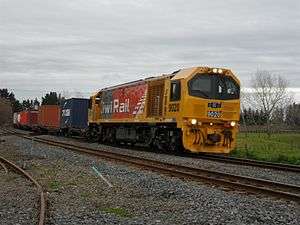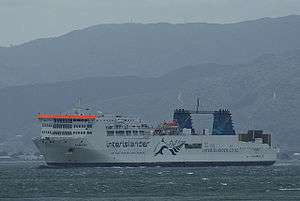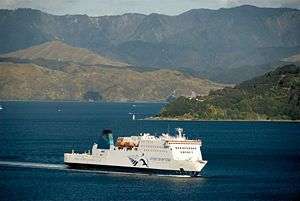KiwiRail
 | |
| State-Owned Enterprise | |
| Industry | Rail transport, shipping, property management |
| Predecessor | Toll NZ |
| Founded | 1 July 2008 |
| Headquarters | Wellington, New Zealand |
Area served | New Zealand |
Key people |
John Spencer (Chairman) Brian Corban (Deputy Chair), Peter Reidy (CEO) |
| Services |
Rail freight Long-distance passenger rail Urban passenger rail Inter-island ferries |
| Revenue |
|
|
| |
| Divisions |
|
| Subsidiaries |
KiwiRail Finance Ltd KiwiRail Ltd |
| Website |
www |
KiwiRail Holdings Limited is a New Zealand State-owned enterprise responsible for rail operations, which trades as KiwiRail. Headquartered in Wellington, New Zealand, KiwiRail is the largest rail transport operator in New Zealand. Since July 2010 John Spencer has been the chairman. KiwiRail Freight, KiwiRail Scenic Journeys and the Interisland Line are all subsidiaries of KiwiRail.
History
KiwiRail was created from a number of entities that date back to the 19th century. Prior to KiwiRail, rail transport in New Zealand has been under both public and private ownership. Government operators included the Public Works Department (1873–1880), New Zealand Railways Department (1880–1982), and the New Zealand Railways Corporation (1982–1990). New Zealand Rail Limited was split off from the Railways Corporation (which continued to own the land beneath the rail network) in 1990, privatised in 1993 and then renamed in 1995 to Tranz Rail. In 2004 Tranz Rail's rail, ferry and trucking operations were taken over by Toll Holdings and renamed Toll NZ, with the central government buying back the rail network under the New Zealand Railways Corporation (trading as ONTRACK). After several years of negotiations the two parties could not come to an agreement on the amount that Toll should pay for access to the rail network (track access fees). In July 2008, the government announced the purchase of Toll Rail from Toll, renaming it KiwiRail. The Railways Corporation then owned both KiwiRail and ONTRACK, but both companies were merged in October 2008[2] to create one company that controls both rail and ferry operations and rail infrastructure. Toll retained ownership of its trucking operation.
Turn-around plan

For 13 years during private ownership, infrastructure investment outside of Wellington dropped to an average of just over $25m a year. Since then it has ranged between $100 and $200m a year.[3]
In the 2010 New Zealand budget KiwiRail received a capital injection of $250 million, and a further $500 million in principle to make it sustainable within a decade. Prime Minister John Key and Minister of Transport Steven Joyce said the injection was part of a $4.6 billion turnaround plan for KiwiRail "designed to see the rail freight become sustainable within a decade by getting it to a point where its costs are funded solely from customer revenue." The $4.6 billion would come from business itself.[4]
KiwiRail describes its turnaround plan as reflecting "the need to create a viable and efficient rail industry capable of meeting its share of freight traffic projected to grow by at least 75 percent by 2031."[5]
The plan aims to increase rail traffic volumes and revenue, increase productivity, modernise assets and separate out the commercial elements of the business from the non-commercial.[5]
The plan includes five major points:[5]
- "Step change" on the Auckland – Wellington – Christchurch "main trunk" route:
- reduce transit time and improve reliability along the route – easing curves, removing speed restrictions, greater renewals investment in bridges and sleepers and passing loops. Currently, an express freight train journey between Auckland and Wellington takes thirteen and a half hours – similar to transit times in the late 1970s. A truck on the same route takes nine hours. KiwiRail aims to reduce transit times to 11 hours.
- Improve exit and entry from Auckland and Wellington – improvements at terminals and on main lines to reduce transit times and conflicts with commuter services
- Increase ferry capacity for rail freight – extend the length of Aratere and make Kaitaki rail capable
- Improve reliability and capacity:
- Increased renewals on "other key routes", investment in replacement of sleepers, strengthening of bridges, refurbishment of track formation.
- Enabling investment:
- The minor lines:
- KiwiRail will review business on:
- North Auckland Line
- Stratford - Okahukura Line (mothballed 2009)
- Napier – Gisborne Line (mothballed October 2012)[7]
- and North Wairarapa line.
- Consultation with communities, customers and staff
- Close or mothball by 2012 if anchor customers do not emerge
- KiwiRail will review business on:
- Clarify and assign accountability for costs associated with operating Auckland and Wellington metro services. As a result, the Tranz Metro assets were transferred to the Greater Wellington Regional Council and contracts for running services were made "contestable' as in Auckland.
Two of KiwiRail's major customers, Mainfreight and Fonterra, have invested heavily in rail-related infrastructure. Mainfreight has allocated $60 million for investment in new railhead depots, while Fonterra has invested $130 million in a new rail hub complex in Hamilton and another in Mosgiel.[8]
In 2013, company Chairman John Spencer stated that over the last three years of the plan, rail freight revenue has increased by over 25%.[9]
Canterbury earthquakes 2010 and 2011
KiwiRail's South Island operations were disrupted by the 2010 Canterbury earthquake, but KiwiRail also participated in disaster relief efforts.[10] Their operations were once again disrupted by the 2011 Canterbury earthquake, resulting in the cancellation of the TranzAlpine and Coastal Pacific passenger trains until 1 March that year.[11]
De-merger
On 31 October 2011, KiwiRail proposed splitting its land and rail corridor assets from its rail operation assets.[12] On 27 June 2012 it was announced by the company that the value of the land and rail operations will be written down from NZ$7.8 billion to $1.3 billion, and KiwiRail will continue as the rail and ferry operator, while the New Zealand Railways Corporation will manage KiwiRail's land.[13] The de-merger took effect on 31 December 2012.[14]
Asset sales
On 19 April 2012 KiwiRail announced it was putting its Hillside Engineering division on the market.[15] In November 2012, KiwiRail announced it would sell off part of the division. Ninety workers will be made redundant when the sale is complete, sometime in early 2013.[16]
In July 2012 it was revealed that KiwiRail was considering selling its Tranz Scenic division, its remaining long-distance passenger services.[17]
Operations
KiwiRail Infrastructure and Engineering
KiwiRail operates services on 3,898 kilometres (2,422 mi) of track, of which around 500 kilometres (310 mi) is electrified. KiwiRail Infrastructure and Engineering maintains and upgrades the network. The division was formerly known as ONTRACK, a trading name introduced in 2004 after the government repurchased all of New Zealand's rail infrastructure from Toll NZ.[19] Rick van Barneveld, former head of Transit New Zealand, is its general manager.
KiwiRail Infrastructure and Engineering has three main areas of operation:
- It is responsible for the maintenance and operation of all of New Zealand's main-line rail infrastructure (see List of New Zealand railway lines).[20]
- It provides rail operators with access to the rail network in return for the payment of track access charges. It is also responsible for the maintenance and development of the network.
- It is the rail network controller, providing services such as train control and signalling.
The network consists of:
- Route length: 3,898 km
- Tunnels: 149
- Bridges: 1,700
- Electrification: 95 km at 1.5 kV DC (Wellington area), 411 km at 25 kV 50 Hz AC (NIMT central section)
Yards and facilities
Some of the more prominent rail facilities used by KiwiRail include:
- Westfield, Auckland
- Southdown, Auckland
- Te Rapa, Fonterra bulk store yard, Hamilton
- Mount Maunganui
- Wellington
- Picton, Marlborough
- Addington, Christchurch (wagon repair)
- Middleton, Christchurch
- Taieri, Fonterra bulk store facility, Mosgiel
KiwiRail Freight
KiwiRail Freight is the company's largest business unit. Freight makes up the majority of KiwiRail's revenue, at $457 million in financial year ended July 2012.[21] KiwiRail moved 4.58 million net tonne kilometers of freight in the same year.[22]
KiwiRail hauls many different commodities, most notably coal and milk, as well as intermodal freight.
One of KiwiRail's major operations is on the Midland line, where unit trains of up to 30 wagons transport coal from the West Coast to Lyttelton.
Interislander
The Interislander is the company's second largest business unit. It operates ferry services across the Cook Strait between Wellington in the North Island and Picton in the South Island. In financial year 2012, $123.9M of KiwiRail's revenue came from the Interislander, with the majority of the Interislander's revenue coming from rail and road freight transport.[21]
Current fleet
The Interislander operates three ferries. In 2011, the Aratere was extended by 30 m to add extra capacity.[23]
| Image | Name | Built | Entered service | Capacity | Notes | ||
|---|---|---|---|---|---|---|---|
| Passengers | Road | Rail | |||||
| |
DEV Aratere | 1998 | 1999 | 600 + 31 crew | 1050 lane metres [23] | 420 lane metres (32 wagons)[23] | Numbers are post 2011 modifications |
 |
MS Kaiarahi | 1998 | 2014 | 550 | 1900 lane metres [24] | none | built 1998 as Dawn Merchant; chartered temporarily by Interislander in 2014 as Stena Alegra while Aratere was out of service, then chartered long-term in 2015 and renamed Kaiarahi |
 |
MV Kaitaki | 1994 | 2005 | 1350 + 60 crew | 1780 lane metres (550 cars) [25] | none | Built 1994 as Isle of Innisfree; chartered by Interislander in 2005 as Challenger; renamed Kaitaki 2007 |
Passenger
KiwiRail Scenic Journeys is the long-distance passenger transport subsidiary of KiwiRail, operating the Capital Connection, Northern Explorer, TranzAlpine and Coastal Pacific.
Suburban rail passenger operations in Auckland and Wellington are contracted by their respective local governments and not operated by KiwiRail. In Auckland rolling stock is owned by Auckland Transport which has contracted operation to Transdev Auckland, while in Wellington rolling stock is owned by Greater Wellington Regional Council which has contracted operation to Transdev Wellington. Until 2016, KiwiRail division Tranz Metro had the contract to operate the Wellington services, but lost a bid to renew this contract in 2015. KiwiRail however is sub-contracted by Transdev Wellington to provide and operate the diesel locomotives required to haul the Wairarapa Connection service.
Current rolling stock
KiwiRail operates a variety of different locomotives, including those for shunting and specific trains used for coal and other transport modes. The table below lists only the current locomotives used by KiwiRail.
| Image | Class | Introduced | Number in class | Number in service | Power output (kW) | Notes |
|---|---|---|---|---|---|---|
| DBR | 1980 | 10 | 3 | 709 | Heavy shunting. 5 stored at Hutt Workshops and 2 scrapped. | |
| DC | 1978–1981 | 85 | 41 | 1230 | Mainline diesel-electric. 21 leased to Auckland Transport. 44 stored at Hutt Workshops. | |
 |
DFT | 1979–1981 | 30 | 22 | 1800 | Mainline diesel-electric. 3 leased to Auckland Transport. 8 stored at Hutt Workshops. |
 |
DH | 1979 | 6 | 6 | 672 | Heavy shunting locomotive. |
 |
DL | 2010–2014 | 48 | 48 | 2700 | Mainline diesel-electric. |
| DSC | 1959–1967 | 70 | 31 | 315 | Shunting. 3 stored at Hutt Workshops | |
| DSG | 1981 | 24 | 24 | 700 | Heavy shunting. | |
| DSJ | 1982 | 5 | 5 | 350 | Shunting. | |
 |
DX | 1972–1975 | 49 | 46 | 2240 | Mainline diesel-electric. Classified DXB and DXC, two rebuilt into DXR, one withdrawn. |
| DXR | 1993 | 2 | 2 | 2420 | Mainline diesel-electric. | |
| EF | 1988–1989 | 22 | 17 | 3000 | 25kV AC electric locomotives. 3 stored at Hutt Workshops. | |
 |
TR | 1936–1978 | 90 | 33 | 138 | Light shunting, positioned in smaller yards and leased to industrial customers. 1 stored at Hutt Workshops. |
Engineering
KiwiRail operates the Hutt Workshops in the Hutt Valley of Wellington. Until 2012 KiwiRail also operated Hillside Engineering in Dunedin, but sold the business to an Australian firm that year.[15]
Corporate governance
| Executive Board | |
| John Spencer | Chairman |
| Dame Paula Rebstock | Deputy Chair |
| Dr Kevin Thompson | Director |
| Mike Pohio | Director |
| Rebecca Thomas | Director |
| Guy Royal | Director |
| John Leuchars | Director |
| Paul Harper | Director |
| Executive Team | |
| Peter Reidy | Chief Executive |
| Kate Jorgensen | Chief Financial Officer |
| Alan Piper | Group General Manager Sales and Commercial |
| Iain Hill | Group General Manager Operations |
| Roy Sullivan | Group General Manager Rolling Stock and Asset Services |
| Huw Bridges | Group General Manager Zero Harm |
| David Gordon | Group General Manager Asset Management and Investment |
| Todd Moyle | Group General Manager Network Services |
| Andrew Norton | Group General Manager Human Resources |
Performance
| Financial year[* 1] | Total revenue | Operating income[* 2] | Net income |
|---|---|---|---|
| 2008-09[26] | $636 million | $63 million | -$186 million |
| 2009-10[27] | |||
| 2010-11[28] | |||
| 2011-12[29] | |||
| 2012-13[21][30][31] | |||
| 2013-14[32] | |||
| 2014-15[1] |
- ↑ Financial year is 1 July-30 June.
- ↑ Operating income is revenue minus operating expenses, also known as EBITA
See also
References
- 1 2 3 "Annual Report 2015" (PDF). KiwiRail Holdings Ltd.
- ↑ "Annual Report 2008-09" (PDF). KiwiRail. Retrieved 23 April 2015.
- ↑ KiwiRail. "Improving the Network - KiwiRail". www.kiwirail.co.nz. Retrieved 2016-06-24.
- ↑ Tracy Watkins (18 May 2010). "KiwiRail gets $250m initial boost". The Dominion Post.
- 1 2 3 "Overview of KiwiRail's turnaround plan" (PDF). KiwiRail. 5 May 2010. Retrieved 6 August 2010.
- ↑ "KiwiRail Orders Another 20 Chinese Locomotives". Otago Daily Times. 20 July 2011. Retrieved 22 July 2011.
- ↑ "KiwiRail to mothball Napier-Gisborne Line". KiwiRail. 2 October 2012.
- ↑ "KiwiRail survival plan is on track". The Dominion Post. 25 September 2010. Retrieved 2010-09-25.
- ↑ "KiwiRail growth momentum 'still on track'". 25 October 2013.
- ↑ "Railway Gazette: KiwiRail recovers from earthquake". Retrieved 2010-09-13.
- ↑ "Canterbury Earthquake halts services - update 3". 22 February 2011. Retrieved 8 October 2013.
- ↑ "No ulterior motive to sell off land or business says KiwiRail". Radio New Zealand. 31 October 2011.
- ↑ Adam Bennett (27 June 2012). "Huge writedown in KiwiRail value".
- ↑ "Positive growth continues alongside improvements to business capability". KiwiRail. 28 February 2013.
- 1 2 "KiwiRail Putting Hillside Workshops Up for sale". Radio New Zealand. 19 April 2012.
- ↑ "Jobs to go at KiwiRail after partial sale". 3 News NZ. 15 November 2012.
- ↑ "Opposition parties criticise TranzScenic plans". Radio New Zealand. 1 August 2012.
- ↑ "Half-million dollar rail project at Waitati". Otago Daily Times. 22 September 2009. Retrieved 2009-09-26.
- ↑ "ONTRACK – a key player in rail renaissance". Volume 3, Issue 1,. Industrial Safety News. Summer 2008. p. Page 22.
- ↑ "Companies Office – ONTRACK Infrastructure Limited". Retrieved 2010-09-25.
- 1 2 3 "Results for announcement to the market – 29 August, 2012" (PDF). KiwiRail. 29 August 2012.
- ↑ "KiwiRail – growing freight". Retrieved 29 August 2012.
- 1 2 3 "Facts and Figures - Aratere". The Interislander.
- ↑ "Facts and Figures - Kaiarahi". The Interislander.
- ↑ "Facts and Figures - Kaitaki". The Interislander.
- ↑ "Annual Report 2008-2009" (PDF).
- ↑ "Annual Report 2009-2010" (PDF).
- ↑ "Annual Report 2010-2011" (PDF).
- ↑ "Annual Report 2011-2012" (PDF).
- ↑ "KiwiRail Annual Report 2013" (PDF). KiwiRail. 2013. Retrieved 21 January 2016.
- ↑ Catherine Harris. "KiwiRail narrows annual loss". Fairfax New Zealand.
- ↑ "Annual Report 2014" (PDF). KiwiRail Holdings Ltd.
External links
KiwiRail subsidiaries
Articles about KiwiRail
- KiwiRail value halves, 'BusinessDay, 3 June 2009.
- KiwiRail under price pressure, 'BusinessDay, 17 April 2009.
- MP at a loss after KiwiRail rejects plea, 'The Marlborough Express, 16 April 2009.
- Trains now called KiwiRail, 'Dominion Post, 30 June 2008.